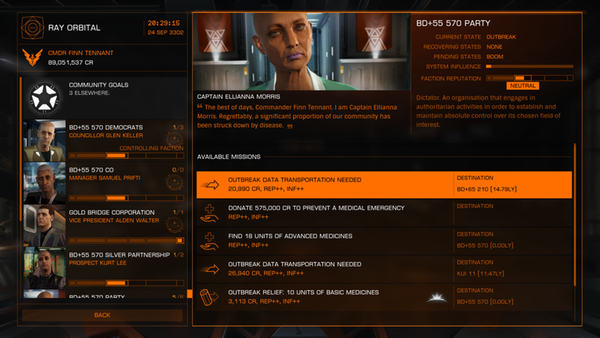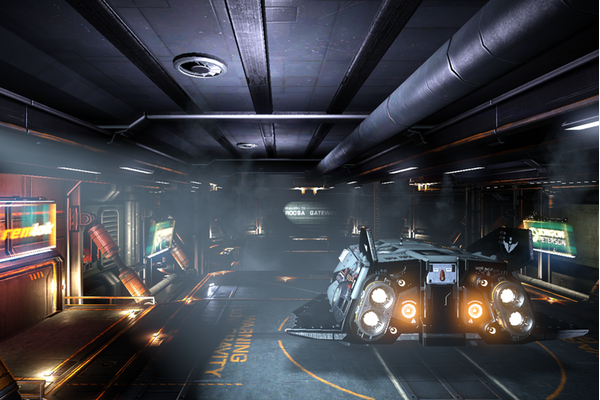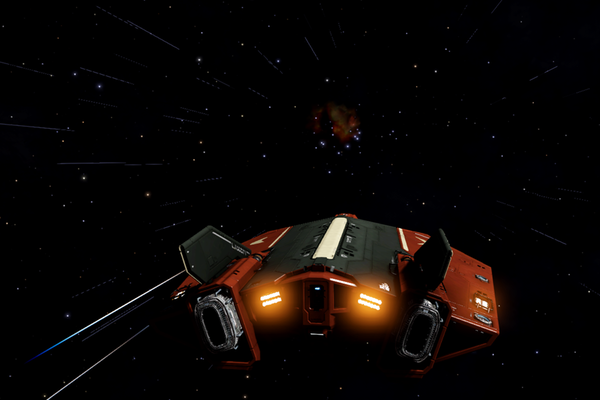Whether you realize it or not, your first few days or weeks in Elite: Dangerous will be spent as a Mercenary. Merriam-Webster has several definitions for Mercenary, but the one I like best, and think is most applicable to Elite: Dangerous, is:
a soldier who will fight for any group or country that hires them: serving merely for pay or sordid advantage
In Elite: Dangerous, you are a member of the Pilots Federation; the trade organization (guild, union, whatever you want to call it) for independent pilots. If you’re familiar with the SyFy series Killjoys (and if you’re not, stop reading right now and go check it out), the Pilots Federation is a lot like The RAC, and by definition is itself a Mercenary organization. Doing combat missions or turning in bounties, doing Trading missions, and selling exploration data will earn you rank in one of three areas with the Pilots Federation: Combat, Trade, and Explorer respectively. Reaching the rank of Elite in any one of the three areas grants you a permit to the Founder’s World.
When you start the game, you’ll be given a Sidewinder and a small stipend of credits by the Pilots Federation, and placed in a random station somewhere in human occupied space. From here on out, you’re on your own. If you are new to Elite: Dangerous and haven’t done any of the supplied training, I highly recommend you at least do the Docking Training: Launch, Travel Training: Travel, and Docking Training: Docking missions and watch the Basic Flight, Basic Combat, Docking, Starport Services, and Travel Training Videos. All of these, and more, can be found under Training in the game’s Main Menu. I’m not going to cover any of those basics here.
The Job
Human inhabited space in the Milky Way, also known as The Human Bubble, or just The Bubble, is controlled by three Superpowers: The Alliance, The Empire, and The Federation. Actual day to day governance is handled by ten Powers (soon to be eleven) who delegate their authority through a plethora of small, local factions scattered throughout The Bubble. These factions, the local ones, are either independent or owe allegiance to one of the Powers who, in turn, are sworn to one of the Superpowers. It’s these local factions that are the Mercenary’s meal ticket.
Every inhabited system will have one or more (usually at least two) local factions vying for control of that system’s stations and resources. Through the Mission Board, in the Starport Services of each system’s stations, these factions will offer missions. Accepting and completing these missions will earn the Mercenary credits and sometimes an additional reward of commodities, materials, and/or resources; it will also earn the Mercenary reputation with the local faction that offered the mission and any Superpower they might be aligned with. As the Mercenary gains reputation with the local faction, they will offer more complex and rewarding missions. Gaining reputation with the Superpowers the local factions are aligned with earns the Mercenary rank with that Superpower which, in turn, grants permits to certain restricted systems and license to purchase some Superpower specific ships.
Why does any of this faction and Superpower stuff matter in a sandbox game? Actually, it doesn’t. If you don’t have any interest in the 8 Superpower specific ships (4 Federation and 4 Empire) or in gaining access to the 10 systems controlled by the Superpowers (3 Empire and 7 Federation) that require permits, you can completely ignore it and just run the missions that look interesting and collect the credits; there are 22 other ships and uncountable systems that don’t require you to be aligned with any one faction or Superpower. But, if any of that stuff sounds appealing, you’ll want to focus your Mercenary’s efforts on missions for local factions aligned with the Superpower you’re interested in. If you are really interested in reputation and rank, you can read up on the Superpowers by following the links above. You also might want to check out these articles on Powerplay and the Background Simulation.
Ranking with the Pilots Federation and/or the Superpowers is about the closest thing to a progression system Elite: Dangerous has. It is also complete optional; you can ignore it and it will happen slowly and organically as you select and complete missions, or you can choose to focus on one or the other or both. All that said, lets get to the meat of the Mercenary.
The Ship
The Mercenary lives and dies by the Mission Board in Starport Services. I’m not going to say every station has a Mission Board, but I can’t think of one I’ve come across that didn’t. The types of missions that can appear on the Mission Board are varied: courier, trade, assassination, hostage rescue, salvage, heist, massacre, and more. The types of missions a Mercenary can accept and successfully and efficiently complete depend entirely on the ship they’re operating.
Every successful Mercenary is a Jack- of-all-Trades and their ship should be too; the more the ship is capable of handling, the more paydays the Mercenary can accrue. This is because not all mission types are offered by all local factions at all times. The number and type of missions local factions will offer is heavily dependent on the State the local faction and system are in, and State changes based on the Background Simulation and player activity. In short, a Mercenary needs options.
The starting ship is a Sidewinder with E rated modules, 4 Tons of cargo space, a Basic Discovery Scanner, and 2 small, gimbaled Pulse Lasers. Despite being the smallest, cheapest ship in the game, its still quite capable of tackling a number of mission types. This is because many mission types don’t require cargo space or specialized tools. In most cases, though, your initial goal will be to get out of the Sidewinder and into something with more options as soon as possible.
The bigger the ship is, the more space it has for modules and the more capacity it has for bigger modules. This means more cargo space, better shields, better drives, room for specialized tools, etc. In other words, more options. You don’t want too big, though, because that limits the stations you can dock with. Less stations, less options. For this reason I’m a firm believer that the best ships for a Mercenary are medium sized ships. So, lets get to work.
Doing the Work …
Your business is missions, and business is good, so, with your stock Sidewinder and initial bankroll of 1000CR, you should head to the nearest station, if you’re not already in one, and check the Mission Board. Don’t worry about changing or adding any modules in your Sidewinder just yet, because you’re going to need that 1000CR for fuel. A good rule of thumb is to always have twice your Rebuy Cost in ready credits for fuel, repairs, and paying the insurance deductible on your ship should you have an unfortunate accident. For a stock Sidewinder, the magic number is about 4000CR.
Theoretically you should be able to take any mission offered, especially if you’re not worried about factions and powers yet, and you can have up to 20 missions in your Transactions log at any one time. Ideally, at this stage, the best missions are Courier, Salvage, and Trade missions, but don’t shy away from missions that look interesting to you. Part of your job at this early stage in the game is figuring our what types of gameplay you find enjoyable; doing different types of missions will help you figure that out. I initially suggest Courier, Salvage, and Trade because these missions force you to use the Galaxy Map, get you lots of practice approaching and docking with stations, and help you learn how to deal with Interdictions.
Courier missions are fantastic. They only require you be able to reach the destination in the time allotted. This is because all you are transporting are encrypted data which are stored on your ship’s computer. They have different names, but they all usually include the key word “data”. You can’t go wrong doing these and sometimes you can get into loops where you’re carrying them back and forth between two specific systems. This is the best as it’s usually only one hop and you’ll be gaining reputation with the local faction and the Superpower as well.
Salvage missions require you have a working Cargo Scoop (standard equipment on all ships) and, usually, 1 – 4 tons of cargo space. A Discover Scanner is also handy, but not necessary. You’ll be given a target system. Go to that system and honk your Discover Scanner, if you have one, or drop out of Supercruise at the Nav Beacon and scan the Nav Beacon. This will give you a more precise location in the system, usually near one of its bodies. Go to that location and slowly Supercruise around the target location until a Mission Specific Unidentified Signal Source (USS) pops up in your contacts list. Drop out of Supercruise into that USS, scoop up the required salvage, and return to the originating local faction.
Trade missions require a lot of cargo space, generally, though you’ll usually be offered them based on your Trade Rank; they can range anywhere from a few tons to several hundred. They all ask you to either deliver commodities to another station, or source commodities from somewhere else and bring them back. Apart from jump distance/range and cargo capacity, they usually don’t require much else.
Finally, Combat missions require you to kill stuff. Sometimes it’s Pirates. Sometimes they’re assassination missions. The targets really don’t matter as far as the ship build is concerned; all you’ll need are guns, shields, and nerves of steel.
The point is there are all sort of missions. There are even hybrids of the mission types discussed above, where you’ll attack something, and then salvage something from the wreckage. Sometimes the local faction will want you to do some mining for them, and bring back the ores. And, very soon, passenger missions will be added. To be a successful and efficient Mercenary, you’ll need a ship that is equipped to tackle as many of these scenarios as possible, so you can roll up on a local faction and accept as many of their missions as you’d like.
… With the Right Tools
The hows and whys of outfitting a ship are a whole topic unto themselves which is why I wrote a whole post on just that topic: Elite Dangerous: Ship Outfitting 101. In that post you’ll, hopefully, find the answers to your questions about ship modules and their types, sizes, and ratings. You’ll also find role specific builds for the starting Sidewinder. I didn’t include one for a Mercenary there, but you can find one I put together here; it doesn’t have a lot of cargo capacity, but it should be enough to do most Salvage missions, plus it has an SRV!
The starting Sidewinder is just that, though: a starting ship. You’re not meant to be in it forever, or for very long, in fact. I personally didn’t spend any money upgrading mine. As soon as I had enough money for a larger ship, I made the jump and you should too. To that end, here are some options along with some builds I put together. Keep in mind, these are just suggestions based on my experience: if you want to try another ship and feel comfortable outfitting it, go for it!
A good upgrade option, from a starting Sidewinder, is the Adder. It’s not the prettiest ship. In fact it’s a bit like tooling around in an Astro Van, but it’s got more firepower, a longer jump range, and more cargo space. It has less armor, but makes up for it with better shields, and handles about the same as a Sidewinder. It also has an extra compartment, for an additional module. I’ve put together an Adder Mercenary loadout over on Coriolis.Io. If you like flying the Adder, it’s something to strive for, but much like the Sidewinder, the Adder is not meant to be a forever ship.
The Cobra Mk III is not only an upgrade from the Adder, it is literally one of the fastest hunks of junk in the galaxy. In every important measure to the Mercenary, the Cobra Mk III is a noticeable improvement over the Adder: armor, shields, speed, jump range, cargo capacity, handling, and firepower all get nice boosts in this zippy little craft. It also has an additional compartment for more tools. By the time most pilots are able to purchase the Cobra Mk III they’ve started to make up their minds about how they like to play the game. For many who go on to specialize in another field, the Cobra Mk III remains the best ship for generic mission running. I’ve put together a Cobra Mk III Mercenary build that makes the most of its capabilities. If you intended to move on to another career, this loadout should serve you well for when you want to run missions. If you’re thinking of making a career of Mercenary work, then I have some other suggestions for you.
The Cobra Mk IV is the Cobra Mk III‘s big brother. The Cobra Mk IV sacrifices speed, jump range, and handling for better shields, more cargo, better firepower, and an additional internal compartment. The sacrifices are minimal, though, for access to more tools and the ability to take on bigger targets. I’ve put together a Cobra Mk IV Mercenary build that I think mitigates many of the sacrifices, making it a good transitional ship. It will make flying it a better experience while you save the credits for the next upgrade.
While the Asp Explorer is a hair slower than the Cobra Mk III, it is a vast improvement, in all other areas, over both the Cobra Mk III and Cobra Mk IV. It has one less internal compartment than the Cobra Mk IV, but because it has bigger compartments it is still able to outfit all the tools available in the previous models. For many, the Asp Explorer is the best multipurpose ship in the game. As such it should be your ultimate goal if you intend to make a career out of being a Mercenary. Here’s a build for an Asp Explorer Mercenary craft that i think makes the best use of this jack-of-all trade’s capabilities.
All this said, I use a Fer-de-Lance as my mission runner. While primarily classed as a Combat Ship, I like the ship, and its capabilities suit my play style. Here’s my Fer-de-Lance build, in case you’re interested. This brings up an important point: the above ship builds and progressions are more guidelines than rules. They’re meant to provide you a jumping off point, not a single path to follow. You may find you enjoy Hostage Rescue missions more than Salvage missions, so switch out the Collector Limpet Controller for a Hatch Breaker Limpet Controller. You might not enjoy Planetary Assault and Salvage missions, so dump the Planetary Vehicle Hanger and add another tool that makes what you do enjoy doing easier. It’s all really up to you.
Wrapping it Up
I hope I’ve manage to show you how playing the Mercenary is really all about what mission types you like, and what capabilities your ship has. Running missions is the purest way to play Elite: Dangerous, and their successful completion is one of the major ways to affect the Background Simulation. Tune in next Wednesday for my post on How to Play a Bounty Hunter!






You ought to start streaming Elite on Twitch.
I would LOVE to stream, but sadly with the max 10mb connection we have out here in the country, it’s not an option. I hold out hope CenturyLink will upgrade their equipment out here one day.
[…] in anything smaller than a Type-6 Transporter. Until you can afford a Type-6, I recommend you run missions (including any source or delivery missions you have cargo space for) or collect bounties until you […]